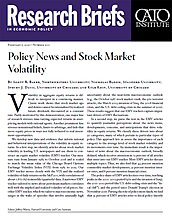We develop new data and evidence that inform rational and behavioral interpretations of the volatility in equity returns. In a first step, we identify articles about stock market volatility in leading U.S. newspapers and use them to construct an equity market volatility (EMV) tracker. Our measure runs from January 1985 to October 2018 and is scaled to match the mean value of the Chicago Board Options Exchange Volatility Index (VIX) from 1985 to 2015. Our EMV tracker moves closely with the VIX and the realized volatility of daily returns on the S&P 500, with correlations of about 0.8 (0.85) in monthly (quarterly) data. A narrower EMV tracker tailored to news about petroleum markets correlates well with the implied and realized volatility of oil prices. Another EMV tracker, which we tailor to macroeconomic news, surges in the wake of episodes that involve unusually high uncertainty about the near-term macroeconomic outlook (e.g., the October 1987 stock market crash, the 9/11 terrorist attacks, the March 2003 invasion of Iraq, the 2008 financial crisis, and the U.S. debt-ceiling crisis in the summer of 2011). These results suggest that our EMV trackers capture important drivers of EMV fluctuations.
In a second step, we parse the text in the EMV articles to quantify journalist perceptions about the news items, developments, concerns, and anticipations that drive volatility in equity returns. We classify these drivers into about 30 categories, many of which pertain to particular types of policy. This approach lets us assess the importance of each category to the average level of stock market volatility and its movements over time. An immediate result is the importance of news about the macroeconomic outlook, broadly defined, which receives attention in 72 percent of all articles that enter into our EMV tracker. Most EMV articles discuss multiple topics. Thus, we also find that 44 percent mention commodity market developments, 31 percent mention interest rates, and 8 percent mention financial crises.
The policy share of EMV articles rises over time, reaching peaks in the 2001–2003 period (9/11 and the invasion of Iraq), the 2011–2012 period (the U.S. debt-ceiling crisis and the “fiscal cliff”), and the period since Donald Trump’s election in November 2016. Parsing the role of policy more finely, we find that 35 percent of EMV articles refer to fiscal policy (mostly tax policy), 30 percent mention monetary policy, 25 percent mention regulation, and 13 percent mention national security matters. We also construct EMV trackers tailored to these policy categories and find that each one fluctuates markedly over time. For example, our national security EMV trackeris low in most periods but highly elevated during the GulfWar, after the 9/11 terrorist attacks, and during the Iraq War. Trade policy matters went from a virtual nonfactor for equity market volatility in the 20 years before Trump’s election to aleading source afterward, especially since the intensification of U.S.-China trade tensions from March 2018.
How should we interpret these findings? According to the efficient-market hypothesis, equity price movements reflect genuine news that alters rationally grounded forecasts of future earnings and discount factors. Under this view, it’s natural to interpret news reports as a catalog of the rational forces that drive the volatility of equity returns.
Economist Robert Shiller articulates a rather different view: “The market fluctuates as the sweep of history produces different mindsets at different points of time, different zeitgeists.… Aggregate stock market price changes reflect inconstant perceptions, changes that [John] Keynes referred to with the term ‘animal spirits.’ ” Under this view, we expect newspaper articles to (imperfectly) mirror these mindsets and their shifts over time. Under either view, we see our methods and measures as helpful in efforts to quantify the perceived drivers of stock market volatility.
Our EMV trackers have several noteworthy attributes: First, their construction is straightforward, transparent, easy to refine, and simple to replicate. Second, the frequency and volume of newspaper text afford much scope for granular characterizations of the forces that underlie EMV and its movements over time. We develop several tailored EMV trackers that exploit this granular richness. Third, our text-based approach is useful for assessing the role of wars, policy risks, and other hard-to-quantify sources of stock market volatility. Fourth, our measurement methods are highly scalable among countries and over time. Although we focus on the volatility of aggregate U.S. equity markets from 1985 onward, our methods extend readily to any country or time period with digital newspaper archives and data on aggregate equity returns. Finally, we update our EMV trackers monthly in real time. These real-time updates facilitate efforts to assess the out-of-sample performance of our measures.
There are several natural directions for future research. First, we are currently using our category-specific EMV trackers to explain and interpret the distribution of firm-level stock price volatilities and its movements over time. Second, by developing EMV trackers for multiple countries, we can explore the specific global and national forces that underlie stock market volatilities around the world. Third, our basic approach could be usefully applied to construct and parse newspaper-based trackers for other concepts. It would be straightforward, for example, to adapt our methods to construct newspaper-based trackers of consumer confidence, business sentiment, and the like and to delve into the specific forces that drive their movements.
NOTE:
This research brief is based on Scott R. Baker et al., “Policy News and Stock Market Volatility,” March 25, 2019, https://ssrn.com/abstract=3363862.

